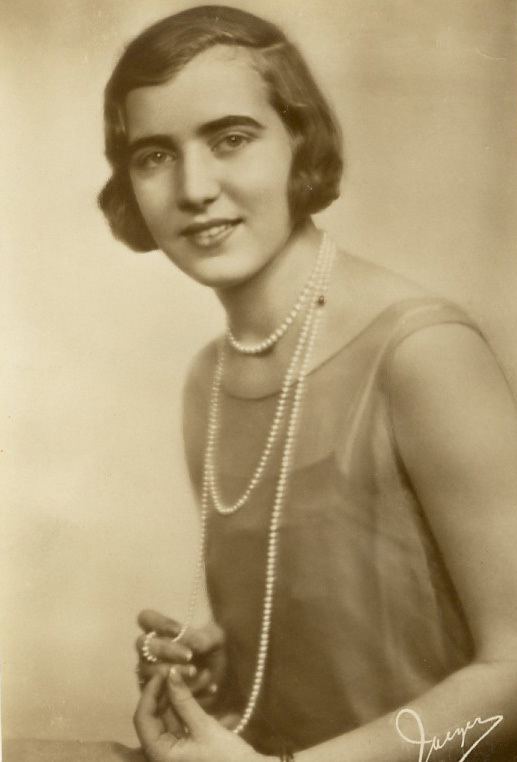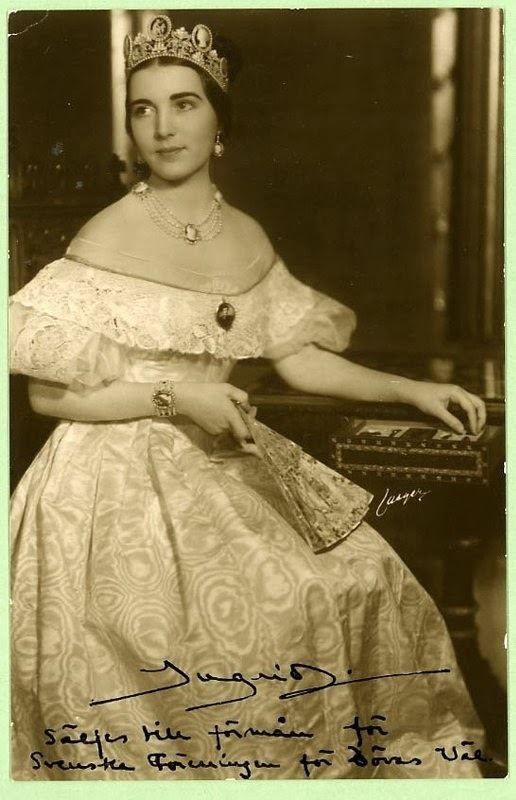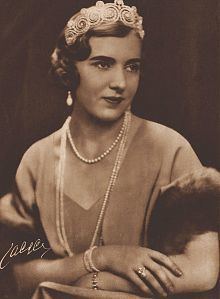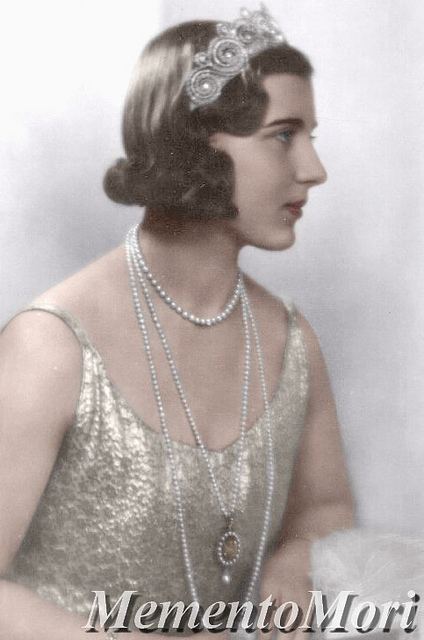Name Ingrid Sweden | ||
Tenure 20 April 1947 – 14 January 1972 Father Gustaf VI Adolf of Sweden Spouse Frederick IX of Denmark (m. 1935–1972) Children Margrethe II of Denmark, Queen Anne-Marie of Greece, Princess Benedikte of Denmark Parents Gustaf VI Adolf of Sweden, Princess Margaret of Connaught Siblings Prince Gustaf Adolf, Duke of Vasterbotten Similar People Frederick IX of Denmark, Margrethe II of Denmark, Queen Anne‑Marie of Greece, Frederik - Crown Prince of, Princess Benedikte of Denmark | ||
tribute to ingrid of sweden queen of denmark
Ingrid of Sweden (Ingrid Victoria Sofia Louise Margareta; 28 March 1910 – 7 November 2000) was Queen of Denmark from 1947 until 1972 as the wife of King Frederick IX.
Contents
- tribute to ingrid of sweden queen of denmark
- Saint of the day september 2 st ingrid of sweden
- Early life
- Marriage
- Crown Princess
- Queen consort
- Queen mother
- Death
- Issue
- Titles
- National honours
- Foreign honours
- References
Born into the House of Bernadotte, she was the daughter of King Gustaf VI Adolf of Sweden and his first wife Princess Margaret of Connaught. In 1935 she married Crown Prince Frederick of Denmark and they had three daughters, Margrethe, the present Queen of Denmark, Benedikte, now a Princess of Sayn-Wittgenstein-Berleburg, and Anne-Marie, the former Greek queen.

In 1947, her husband became king on his father's death. As queen, Ingrid reformed the traditions of Danish court life, abolished many old-fashioned customs at court and created a more relaxed atmosphere at official receptions. King Frederick IX died in 1972, and Ingrid's daughter Margrethe became queen.

She was also an aunt of the present King of Sweden, Carl XVI Gustaf.

Saint of the day september 2 st ingrid of sweden
Early life

Princess Ingrid was born on 28 March 1910, at the Royal Palace in Stockholm as the third child and only daughter of Gustaf Adolf, Crown Prince of Sweden and his first wife, Princess Margaret of Connaught. Her father was the eldest son of King Gustaf V of Sweden by his wife, Princess Victoria of Baden. Her mother was a daughter of Queen Victoria's third son Prince Arthur, Duke of Connaught and Strathearn by his wife Princess Louise Margaret of Prussia.

She was baptised Ingrid Victoria Sofia Louise Margareta in Slottskyrkan (the Royal Chapel) in Stockholm, Sweden on 5 May 1910. Her godparents were: King Gustav V and Queen Victoria of Sweden (her paternal grandparents), Queen Sofia of Sweden (her father's paternal grandmother), the Duke and Duchess of Connaught and Strathearn (her maternal grandparents), Grand Duchess Louise of Baden (her father's maternal grandmother), Empress Alexandra of Russia (her mother's paternal first cousin) Princess Alice, Countess of Athlone (her mother's paternal first cousin), King George V of the United Kingdom (her mother's paternal first cousin), Prince Adalbert of Prussia (her second cousin), Grand Duchess Hilda of Baden and Duchess Therese of Dalarna.

The family lived in apartments in the Royal Palace in Stockholm, in a mansion at Ulriksdal, near the capital, and in a summer residence, Sofiero Castle in Scania in southern Sweden. In 1920, when Ingrid was just ten years old, her mother died from meningitis while in the eighth month of her sixth pregnancy. Her father remarried Lady Louise Mountbatten three years later. Louise was a second cousin of Ingrid's. Only a stillborn daughter resulted from her father's second marriage. Ingrid felt betrayed by her father when he thus remarried, and she was unkind to Crown Princess Louise, not becoming reconciled to that marriage until she acquired a more adult understanding, many years later.
Ingrid was raised to a sense of duty and seriousness. She was well educated and interested in sports, especially horse-riding, skiing and tennis. She also got her driver's licence early.
Marriage
The question of Ingrid's marriage was a hot topic of conversation in the 1920s. She was matched with various foreign royalties and was seen by some as a possible wife for the heir-apparent to the British throne, the Prince of Wales, who was her second cousin. Her mother, Margaret of Connaught, and the then-Prince of Wales' father, King George V, were first cousins, both being grandchildren of Queen Victoria. In 1928, Ingrid met the Prince of Wales in London. However, no engagement took place.
On 15 March 1935, shortly before her 25th birthday, she was engaged to Frederick, Crown Prince of Denmark and Iceland. They were related in several ways. As descendants of Oscar I of Sweden, they were third cousins. Through Leopold, Grand Duke of Baden, they were third cousins. And finally through Paul I of Russia, Frederick was a fourth cousin of Ingrid's mother. They married in Stockholm Cathedral on 24 May 1935. Among the wedding guests were the King and Queen of Denmark, the King and Queen of Belgium and the Crown Prince and Crown Princess of Norway. Her wedding was one of the greatest media events of the day in Sweden in 1935, and received so much attention that the media were criticised for it. Ingrid also appeared on the radio in 1935 and read a poem, something which was also given much attention.
Crown Princess
While she was Crown Princess, she was the official patron of the Girl Guides (1936), after having taken, and passed, the same tests all applicants were given. In 1940, before the occupation, she was the leader of the Danske Kvinders Beredskab (The Danish Women's war-effort society). During the German occupation of Denmark in World War II, Ingrid, with her personal courage and integrity, influenced the Danish Royal House and its conduct in relation to the occupation forces, and won great popularity as a symbol of silent resistance and public patriotic moral. She showed solidarity toward the Danish population, and could often be seen on her bicycle or with her baby carriage on the streets of Copenhagen during the war. Her open defiance of the occupation forces made her grandfather, King Gustav of Sweden, worry about the risks, and in 1941, he sent a demand to her to be more discreet "for the sake of the dynasty" and its safety, but she reacted with anger and refused to obey, and she had the support of her spouse, who shared her views. One display of defiance shown by Ingrid was her positioning of the flags of Denmark, Sweden and the United Kingdom in the window of the nursery at Amalienborg, the royal residence in the centre of Copenhagen.
Queen consort
Upon her husband's accession to the throne on 20 April 1947, she became the Queen of Denmark. As such, she reformed the traditions of Danish court life, abolished many old-fashioned customs at court and created a more relaxed atmosphere at official receptions. She was interested in gardening and art, and renovated the Gråsten Slot according to her own historical research about the palace's original appearance.
Queen mother
In 1972, King Frederick IX died, and Ingrid was widowed at the age of 61. Her elder daughter, aged 31, became the new queen, and Ingrid now assumed a position as family matriarch. That same year, after having sworn to respect the Danish constitution, she was appointed Rigsforstander (formal Regent) and representative of the monarch whenever her daughter (and later her grandsons) were absent, a task she performed on many occasions. This was exceptional; since the constitution of 1871, only the Crown Prince had been allowed to act as regent in the absence of the monarch.
She was patron of a long line of social organizations, positions which, one after another, she eventually left to Princess Benedikte as years passed: Røde Kors, Ældre Sagen, Red Barnet, Løgum Klosters Refugium, and Fonden for Træer og Miljø. She also founded the organizations Kong Frederik og Dronning Ingrids fond til humanitære og kulturelle formål, Ingridfondet for South Jutland, Det kgl. Grønlandsfond, and Dronning Ingrids Romerske Fond til støtte af kulturelle og videnskabelige formål. She was described as dutiful, well-prepared and energetic. She learned Danish quickly. She was also a feminist and felt strongly for gender equality.
Death
Queen Ingrid died on 7 November 2000 at Fredensborg Palace, Fredensborg, with her three daughters—Queen Margrethe II, Princess Benedikte and Queen Anne-Marie of Greece—and ten grandchildren at her bedside. Thousands gathered outside Amalienborg Palace, her official residence, after her death was announced; flowers were left, candles were lit and hymns were sung in her honour. Her funeral took place on 14 November 2000, and Ingrid was interred next to her husband, King Frederick IX, outside Roskilde Cathedral near Copenhagen. The funeral was attended by many crowned heads of Europe and other heads of state, among them the King and Queen of Sweden, The Queen of Spain, The Queen of the Netherlands, The King and Queen of Norway, The King and Queen of the Belgians, The Grand Duke and Grand Duchess of Luxembourg, The Prince of Wales, The Hereditary Prince of Monaco, Ólafur Ragnar Grímsson, the President of Iceland and Mauno Koivisto, the former President of Finland.
Issue
Queen Ingrid and King Frederick IX have three daughters, ten grandchildren and twenty-one great-grandchildren.
